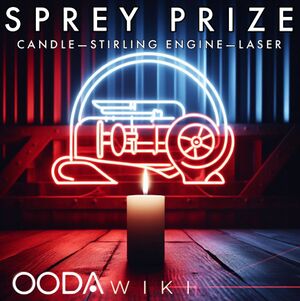The Sprey Prize: Winter 2023/2024 event marks the inaugural edition of the Sprey Prize engineering competition, an open-source challenge that invites engineers and innovators to push the boundaries of new and not-so-new technology.
Commencing on October 2, 2023, this competition challenges participants to design and develop a prototype capable of harnessing the heat from a standard candle to power a Stirling engine, manufactured with 3D printers and/or computer numerical control (CNC) machines, which subsequently drives a laser device.
The competition, drawing inspiration from the visionary work of Pierre Sprey, Colonel John Boyd, and the Fighter Mafia--encourages creativity, innovation, efficiency, and focus in design.
Background
Candles
Candles have played a significant role in human history for thousands of years as a source of light. Ancient civilizations used various materials, such as beeswax and tallow, to create early candle-like sources of illumination. Over time, candle-making techniques evolved, leading to more efficient and longer-lasting candles. In the modern era, candles have found applications beyond mere illumination. They are used in religious ceremonies, as decorative items, and in aromatherapy. Recent innovations have also seen candles employed in emergency lighting and as eco-friendly alternatives to electric lights.
Stirling Engines
The Stirling engine, named after its inventor Robert Stirling in the early 19th century, is a unique heat engine that operates on the principle of cyclic compression and expansion of gas. Unlike internal combustion engines, Stirling engines are external combustion engines, which means they can run on various heat sources, including candles. Historically, Stirling engines were used in applications like water pumping and electricity generation. Today, they find use in niche applications, such as solar power generation, where their efficiency and quiet operation are advantageous. Future applications could include waste heat recovery in industrial processes and as a clean and efficient power source for space exploration.
Lasers
The development of lasers (Light Amplification by Stimulated Emission of Radiation) began in the mid-20th century, with the first working laser constructed by Theodore H. Maiman in 1960. Lasers emit focused beams of coherent light with various properties depending on their design. Lasers have had a profound impact on science, technology, and industry. They are used in fields as diverse as telecommunications, medicine (surgical procedures and diagnostics), manufacturing (cutting, welding, and engraving), and entertainment (laser light shows). Advances in laser technology continue to expand their applications, including in precision measurement, quantum computing, and directed energy weaponry. The use of lasers powered by unconventional sources, such as candles, represents an intriguing challenge and an opportunity for innovation in laser technology.
Competition Rules and Guidelines
The Sprey Prize: Winter 2023/2024 competition presents participants with a set of specific rules and guidelines available here.
